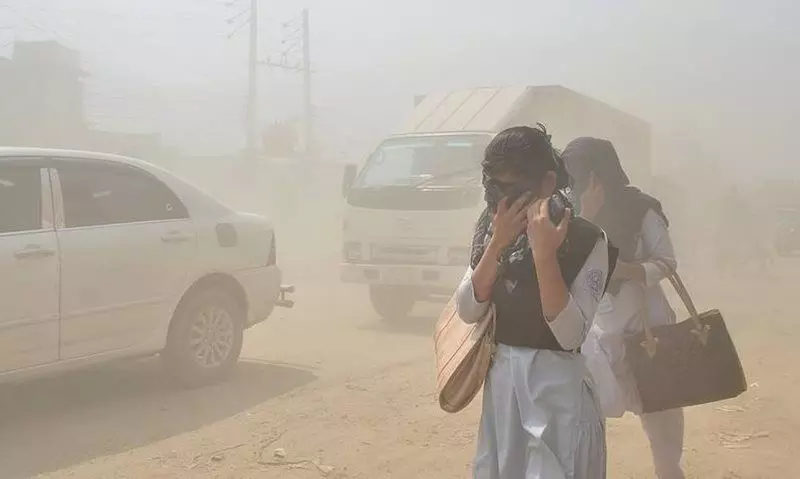Indians losing 5 years of life due to air pollution; in Lucknow city it is a loss of 9.5 years
In the Indo-Gangetic plains of Northern India, 510 million residents, nearly 40% of India’s population, are on track to lose 7.6 years of life expectancy on average, if current pollution levels persist, warns a new study. Since 2013, about 44% of the world’s increase in pollution has come from India.
 गाँव कनेक्शन 15 Jun 2022 9:40 AM GMT
गाँव कनेक्शन 15 Jun 2022 9:40 AM GMT

Permanently reducing air pollution to the WHO guideline would increase global average life expectancy from roughly 72 to 74.2 years, and in total, the world’s population would gain an astounding 17 billion life-years.
In no area of the world is the unsurmountable challenge of air pollution more evident than in South Asia, where despite economic slowdowns due to the COVID pandemic, pollution has continued to rise. India, Pakistan, Bangladesh, and Nepal — where nearly a quarter of the global population lives — remain among the top five most polluted countries in the world.
India faces the highest health burden of air pollution due to its high particulate pollution concentrations and large population. Indians are losing five years of their life due to air pollution, warns a new study by the Energy Policy Institute at the University of Chicago (EPIC) based on its Air Quality Life Index (AQLI).
The situation is worse in the Indo-Gangetic belt of north India, where 510 million residents, nearly 40 per cent of India's population, are on track to lose 7.6 years of life expectancy on average, if current pollution levels persist, says the study. Residents of Lucknow in Uttar Pradesh stand to lose 9.5 years of life expectancy if pollution levels persist.
The AQLI makes the abundant stream of scientific evidence on air pollution's impact on human health even more poignant. Measured in terms of life expectancy, the AQLI shows that ambient particulate pollution is consistently the world's greatest risk to human health. Particulate pollution is set to reduce global average life expectancy by 2.2 years, warns the new study. South Asia accounts for more than half, 52 per cent, of the expected lost life years globally due to high pollution.
India, a pollution hotspot
Since 2013, about 44 per cent of the world's increase in pollution has come from India, where the particulate pollution level has increased from 53 microgram per cubic metre (µg/cum) then, to 56 µg/cum today — roughly 11 times higher than the WHO guideline, found the EPIC study.
The health cost of air pollution far outweighs malnutrition. Researchers point out that child and maternal malnutrition reduces average life expectancy by about 1.8 years in India, while smoking reduces the average life expectancy by 1.5 years. However, air pollution is reducing life expectancy in India on average by five years.
Residents of Lucknow in Uttar Pradesh stand to lose 9.5 years of life expectancy if pollution levels persist.
Virtually all, 99.9 per cent, of Southeast Asia's roughly 650 million people now live in areas where particulate pollution exceeds the revised WHO guideline of 5 µg/cum. Across the region, air pollution reduces average life expectancy by 1.5 years, relative to what it would be if the WHO guideline was met. In the 11 countries that make up this region, an estimated 959.8 million person-years are lost due to air pollution.
Permanently reducing air pollution to the WHO guideline would increase global average life expectancy from roughly 72 to 74.2 years, and in total, the world's population would gain an astounding 17 billion life-years.
Action on air pollution
In 2019, the Government of India declared a "war on pollution" and launched its National Clean Air Programme (NCAP) with the stated goal of reducing 2017 particulate pollution levels by 20 to 30 per cent by the year 2024. Since then, India has adopted fuel emissions standards that are on par with European Union standards.
Although the NCAP targets are non-binding, achieving and sustaining such a reduction would increase India's national life expectancy by as much as 1.6 years, and by as much as 3.2 years for residents of Delhi.
Other countries across South Asia are beginning to take policy actions as well. Nepal has instituted an Air Quality Management Action Plan for Kathmandu Valley, and adopted various other policies to control emissions from vehicles and industries, and manage air quality.
In Pakistan, the government began installing more pollution monitors and shutting down factories in highly polluted districts during the winter months, when energy demand for heating is high.
Similarly, Bangladesh is expanding its monitoring capacity and real-time air pollution measurements; they are expected to soon cover eight cities, up from the four that are covered today.
The recent study applauds China's policies to reduce air pollution. China's pollution has been decreasing since the country began a "war against pollution" seven years ago. This decline continued through 2020, with pollution levels down 39.6 per cent compared to 2013.
Indonesia saw a 20 per cent decline in pollution from 2019 to 2020, and Malaysia likewise saw its pollution decline by 34 per cent. Cambodia, Thailand and Myanmar — all less impacted by Indonesia's fire events — saw increases in particulate pollution from 2019 to 2020.
#Air pollution #Air Pollution India health crisis
More Stories




